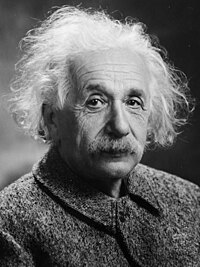AQA A-Level Physics/Particles and Anti-particles

The idea of mass and energy
editEinstein's most famous equation is . Although this equation is quite well known, not many people really understand what it means. To truly understand the significance of Einstein's work, we have to understand a few things about the history of Physics.
Before Einstein wrote down his equation, our understanding of the world was based mainly on ideas from the theories of motion and gravitation that were written down by Sir Isaac Newton.[1] These ideas, along with theories on heat and light that were worked out in 19th century, make up what we call Classical Physics.
Newton's theory was a powerful tool for making predictions about the positions of the planets and the trajectories of cannon balls. In Newton's theory the motion of objects could be measured with reference to a universal reference frame that was the same for everyone, irrespective of their relative motion. Also, time was assumed to pass at the same rate for everyone everywhere. In addition to this, energy was thought of as something that was passed from one object to another but the mass of any particular object had nothing to do with its motion or how much energy it had.
In Einstein's theory the mass of an object is intimately connected with its energy. In fact, mass and energy turn out to be different ways of looking at the same thing. In Einstein's universe mass can change into energy and energy can change into mass. Just how much energy we can get from a certain amount of mass is given by Einstein's famous formula .
The Play Dough Idea
editImagine that something like a car, is made of play dough. Now, when you have play dough you can rip bits off and make other things out of it. Now, imagine that when the play dough is made into something, it goes hard and you have a solid object, but when it's soft, it's easy to model into other things. That's kind of like how energy works when you're talking about particles.
Basically, energy and mass are interchangeable, and anything that has mass has an energy amount, which is larger, associated with that mass. This broke free of the Newtonian ideas, as he said objects at rest have no energy associated with them.
Particles
editNow, you may be thinking about why particles are so important. Who cares if something super-small exists and does x, y and z ? Well, lots of people—and you too will find it important because it describes something which is interesting because it's happening millions of times around you in a split second!
Now, if you remember the original things were the proton, the neutron and the electron, which are what the majority of all atoms (except anti-hydrogen) are made out of. Now, you think of these being the only particles there are, but, unfortunately, there's lots of other kinds of particles which are smaller and do all kinds of crazy things! In this bit, we've got a lot to go into, but it's all very easy stuff, and if you remember one key rule, you'll be fine.
- These concepts were created by humans, and are understood by them.
Anti-particles
editThese lovely things sound like they're straight out of Star Trek, but they're nowhere near as complicated when you think about it. They're basically the reverse image of the normal particle, and have similar properties and have a similar structure, but they're the mirror image.
Have you ever heard in maths where if you do +1 and add it with -1? Well, that's how it happens with particles and antiparticles. Now.. are you ready to get into the nitty-gritty of the particles? It's not hard, i promise you.